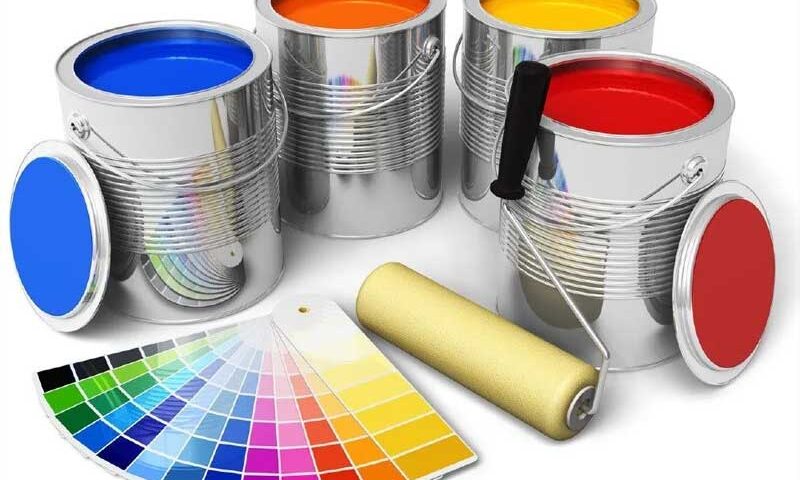The most important thing in selecting paints for this group of rooms is their innocuousness. High requirements are also placed on decorativeness and resistance to sunlight. Wash ability is not a favourite feature unless it is required in a child’s room. It is very good if the paint is odorless or almost odorless during application. It is also desirable that the paint dries fast.
Water based paints
Most of all these requirements are met by water-based paints. They may contain different binders and therefore have different qualities, but they have one thing in common: they are harmless to people, do not damage the surroundings, they dry fast and are almost odourless.
Emulsion water
The most popular paints in this group are water-based emulsion paints. They are based on polyvinyl acetate (more known to us as PVA). This paint is easy to apply and has good hiding power, so two coats will normally be enough to achieve even colour. After drying they create a thick film on the surface that lets the water vapors through, and they say that such a wall “breathes”. It can be tinted very well – any colour can have dozens of shades.
One of its main advantages is its low price. And this is probably the decisive factor that makes water-based paint a leader in sales, even in spite of its rather serious shortcomings.
The first serious disadvantage is that it is not mechanically or abrasion-resistant (it is easy to scratch). The second is that it doesn’t hide surface imperfections and requires careful preparation. For the wall to look good, it has to be perfectly smooth. The third drawback is a fear of water. A wall coated with water-based emulsion can be wiped with a damp cloth several times, but not all shades. Streaks will be clearly visible on some shades. Instead, you can paint the wall a little “in reserve” to remove spots and abrasions that will show up after a while in the most “stressed” areas.
Silicone water-dispersion paints
These paints are almost ideal. They are easy to apply, and can even tighten cracks up to 2mm which are not too bad. The film that remains after drying does not fade, is not afraid of moisture, it is difficult to damage (you can wash as much as you like). Painting house walls with silicone paint results in a very smooth surface, even without perfect preparation and careful levelling.
After drying, the film is so smooth that even microparticles are not trapped on it and dust does not accumulate. What is important is that the paint is vapour-permeable which means it can also be used in damp rooms. Its high resistance to ultraviolet light makes it suitable for exterior decoration (its main use).
It has basically one disadvantage: its high price. It is the most expensive paint available today (except for textured paints). That explains the fact that it’s not very popular. But if you want to have a durable, beautiful wall covering in your house, choose silicone paint. At any rate, you can use it in the hallway and kitchen.
Acrylic water-based
This type of paint is probably the best. It can be tinted and does not burn out, applies well and even covers cracks, though in smaller sizes up to 0.7-1 mm. It has medium water vapour permeability, the coating is difficult to damage, and can be cleaned even with detergents. It does not have any particular disadvantages. In some respects (water vapour permeability), it is slightly worse than water-based emulsion paints and in some respects (hiding power) slightly inferior to silicone paints, but in general it gives very good results. Painting a wall in a house with this paint will not be too expensive: the price is average. So if you take the price/quality ratio it is the best paint, both for walls and for the ceiling.
Decorative textured paints
It’s a relatively new trend. Painting the walls in a house with textured paints can not get smooth, evenly painted surface, and having a certain or random relief. The base of texture paints is an acrylic aqueous dispersion with pigments and various additives like sand of different fractions, mineral fibres and other similar substances which form the relief.
They differ in thickness and can be applied by trowel, brush or roller. Some types allow the use of a spray gun. The texture may vary significantly depending on the type of application. In the photo below, for example, you can see the result of applying the same paint with different tools with a brush, different rollers and a trowel. It can be tinted in any colour from the palette, so there are many variations. It can be applied on plasterboard, concrete, chipboard, fibreboard, plastered surfaces. For the best effect the preliminary priming is desirable.
There are decorative paints with simulations of fabric, suede, pearlescent, aged surfaces and many others. The application is sometimes multilayer, in three or more layers, using different tools. Usually such formulations are accompanied by detailed instructions on how to apply and how to work, as well as recommendations on the choice of tools.

